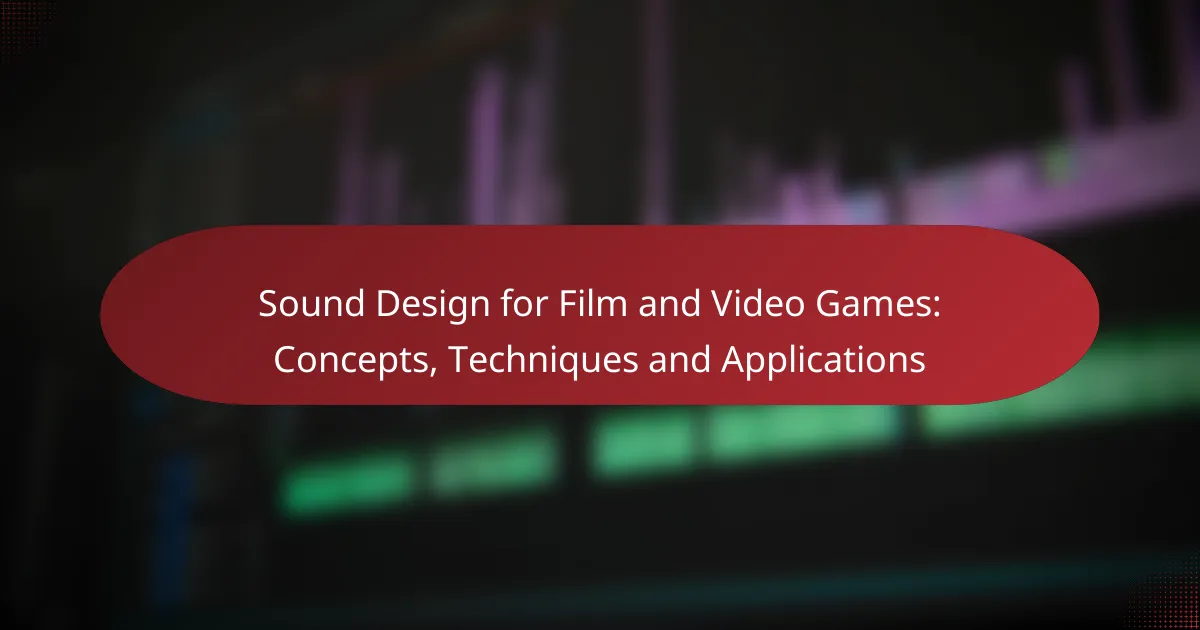Sound design for film and video games is an essential aspect of storytelling that enhances the audience’s experience through various techniques such as Foley artistry, sound layering, and spatial audio implementation. By understanding key principles like sound perception and emotional impact, sound designers can create immersive environments that complement visual elements and engage viewers or players. Selecting the right sound design software is crucial, as it should align with project needs and personal workflow to achieve the desired auditory effects.

What are the best sound design techniques for film and video games?
The best sound design techniques for film and video games include Foley artistry, sound layering, ambience creation, dynamic range manipulation, and spatial audio implementation. Each technique plays a crucial role in enhancing the overall auditory experience, ensuring that sound complements the visual elements effectively.
Foley artistry
Foley artistry involves creating and recording everyday sound effects that are added to film and video game productions in post-production. This technique enhances realism by matching the sounds to the actions on screen, such as footsteps, rustling clothes, or the clinking of objects. A skilled Foley artist can make these sounds using various props and techniques, often in a studio setting.
To achieve effective Foley, it’s essential to synchronize the sounds precisely with the visuals. Using high-quality microphones and recording equipment can significantly improve the clarity and impact of the sounds. Common pitfalls include overlooking the subtlety of sounds or failing to match the scale of the action, which can break immersion.
Sound layering
Sound layering is the process of combining multiple audio elements to create a rich and complex soundscape. This technique allows sound designers to build depth and texture by overlapping sounds, such as combining dialogue, music, and sound effects. Layering can enhance emotional impact and provide a more immersive experience for the audience.
When layering sounds, consider the frequency ranges of each element to avoid muddiness. Use EQ to carve out space for each layer, ensuring clarity. A common approach is to start with a base layer, such as ambient sounds, and gradually add additional elements, like effects and music, to build complexity.
Ambience creation
Ambience creation involves designing background sounds that set the mood and context for a scene. This can include natural sounds like wind, rain, or city noise, which help to establish the environment and immerse the audience. Effective ambience contributes to the storytelling by enhancing the emotional tone and providing a sense of place.
To create compelling ambience, gather field recordings or use sound libraries that offer high-quality environmental sounds. Pay attention to the volume levels; ambience should support the main audio elements without overpowering them. Consider the scene’s context and adjust the ambience accordingly to reflect the time of day or location.
Dynamic range manipulation
Dynamic range manipulation involves adjusting the volume levels of audio elements to create contrast between the quiet and loud sounds in a production. This technique is crucial for maintaining listener engagement and ensuring that important audio cues are heard clearly. A well-managed dynamic range can evoke emotions and highlight key moments in a film or game.
When manipulating dynamic range, use compression to control peaks and maintain a balanced sound. However, avoid over-compression, which can lead to a flat sound. Aim for a dynamic range that suits the genre; for instance, action scenes may benefit from a wider range, while dialogue-heavy scenes might require a more controlled approach.
Spatial audio implementation
Spatial audio implementation creates a three-dimensional sound experience, allowing listeners to perceive sound from various directions. This technique is particularly important in video games, where players need to locate sounds in a virtual environment. Spatial audio enhances immersion by making the auditory experience more realistic and engaging.
To implement spatial audio, consider using binaural recording techniques or surround sound formats. Ensure that sounds are positioned accurately in the audio field, reflecting their source’s location. Testing the audio on different playback systems, such as headphones and surround sound setups, can help ensure a consistent experience across platforms.

How to choose sound design software?
Choosing sound design software depends on your specific needs, budget, and the type of projects you work on. Consider factors such as usability, compatibility with your operating system, and the features that best support your workflow.
Pro Tools for professional use
Pro Tools is widely regarded as the industry standard for professional sound design, especially in film and music production. It offers advanced editing capabilities, high-quality audio processing, and extensive plugin support, making it ideal for complex projects.
When selecting Pro Tools, consider the different versions available, such as Pro Tools Standard and Pro Tools Ultimate, which cater to varying levels of professional needs. Be prepared for a learning curve, as mastering its features can take time.
Ableton Live for music integration
Ableton Live excels in music integration and is particularly favored by electronic music producers and sound designers. Its intuitive interface and session view allow for easy experimentation with sounds and arrangements.
For those looking to create soundscapes or integrate music into video games, Ableton Live’s powerful MIDI capabilities and real-time audio manipulation make it a strong choice. It’s beneficial to explore its extensive library of sounds and effects to enhance your projects.
Adobe Audition for post-production
Adobe Audition is a versatile tool for audio post-production, offering features tailored for editing, mixing, and restoring audio. It integrates seamlessly with other Adobe Creative Cloud applications, making it suitable for video editors and sound designers alike.
When using Adobe Audition, take advantage of its multitrack editing capabilities and built-in effects to polish your audio. It’s particularly useful for cleaning up dialogue and sound effects in film and video projects.
Logic Pro for Mac users
Logic Pro is a comprehensive sound design software specifically designed for Mac users, featuring a wide array of virtual instruments and effects. It is well-suited for music production, sound design, and film scoring.
Consider the extensive library of loops and samples available in Logic Pro, which can significantly speed up your workflow. Its user-friendly interface allows for quick navigation, making it easier to create and manipulate sounds effectively.

What are the key principles of sound design?
The key principles of sound design involve understanding how sound interacts with the audience and enhances the narrative experience. These principles include sound perception, emotional impact, and maintaining consistency in audio quality throughout the project.
Sound perception and psychology
Sound perception refers to how audiences interpret and respond to audio elements in film and video games. Factors such as frequency, volume, and spatial positioning significantly influence how sound is experienced. For instance, low-frequency sounds can create a sense of tension, while high-frequency sounds may evoke excitement or alertness.
Understanding the psychology behind sound can help designers craft audio that aligns with the intended emotional responses. Using techniques like sound masking or layering can enhance immersion, making the audience feel more connected to the story or gameplay.
Emotional impact of sound
Sound has a profound emotional impact, shaping how viewers and players feel during key moments. For example, a suspenseful score can heighten tension, while a soft melody may evoke nostalgia. Designers should consider how different sounds can reinforce or contrast with visual elements to amplify emotional storytelling.
To effectively utilize sound for emotional impact, it’s essential to match audio cues with visual narratives. Using silence strategically can also create powerful moments, allowing the audience to absorb the gravity of a scene.
Consistency in audio quality
Consistency in audio quality is crucial for maintaining immersion and professionalism in sound design. Variations in volume, clarity, or effects can distract the audience and detract from the overall experience. It’s important to establish a baseline for audio levels and adhere to it throughout the project.
To ensure consistency, sound designers should regularly monitor audio levels during production and post-production. Utilizing tools like loudness meters can help maintain appropriate levels across different platforms, ensuring that the sound experience remains uniform whether in a theater or on a personal device.

How does sound design enhance storytelling in film?
Sound design significantly enhances storytelling in film by creating immersive experiences that engage audiences emotionally. It complements visuals, conveys character emotions, and supports narrative arcs through auditory elements.
Creating atmosphere and mood
Sound design plays a crucial role in establishing the atmosphere and mood of a film. By using ambient sounds, music, and sound effects, designers can evoke feelings such as tension, joy, or nostalgia. For example, a suspenseful scene may feature low, rumbling sounds to create unease, while a romantic moment might be accompanied by soft, melodic music.
To effectively create atmosphere, consider the genre and emotional tone of the scene. Use sound layers to build complexity, mixing background sounds with foreground elements to enhance the viewer’s experience.
Character sound motifs
Character sound motifs are unique auditory cues associated with specific characters, helping to reinforce their identity and emotional state. These motifs can include distinct musical themes, specific sound effects, or even voice characteristics. For instance, a villain might have a menacing theme that plays whenever they appear, signaling their presence and intentions.
When developing sound motifs, ensure they are consistent and recognizable. This helps audiences connect emotionally with characters and enhances the storytelling by providing auditory context for their actions and motivations.
Sound cues for narrative progression
Sound cues are essential for guiding audiences through a film’s narrative progression. They signal transitions, highlight important moments, and indicate changes in tone or pace. For example, a sudden silence might indicate a pivotal moment, while a crescendo can build anticipation for an upcoming event.
To use sound cues effectively, align them with visual elements and narrative beats. Avoid overusing cues, as this can lead to predictability; instead, aim for subtlety and variation to maintain audience engagement throughout the film.

What are the applications of sound design in video games?
Sound design in video games enhances the overall experience by creating immersive environments, conveying emotions, and providing feedback to players. It plays a crucial role in storytelling, gameplay mechanics, and establishing atmosphere.
Enhancing immersion
Sound design significantly enhances immersion by creating a believable audio landscape that complements the visual elements of a game. Background sounds, ambient noise, and spatial audio help players feel as though they are truly part of the game world. For example, the rustling of leaves or distant thunder can make a forest setting feel alive and dynamic.
Conveying emotions
Effective sound design conveys emotions and sets the tone for various game scenarios. Music, sound effects, and voice acting can evoke feelings of tension, joy, or sadness, influencing player reactions. For instance, a suspenseful score during a chase scene can heighten anxiety, while uplifting music during a victory can enhance the sense of achievement.
Providing feedback
Sound design serves as a crucial feedback mechanism for players, indicating actions, successes, or failures. Audio cues, such as the sound of a weapon firing or a character’s footsteps, inform players about their interactions within the game. Clear and distinct sounds help players understand the consequences of their actions, improving gameplay experience and engagement.
Supporting storytelling
Sound design supports storytelling by reinforcing narrative elements and character development. Voiceovers, sound effects, and thematic music can provide context and depth to the plot. For example, a character’s emotional state can be highlighted through their voice modulation and the accompanying music, enriching the player’s understanding of the story.
Creating unique identities
Unique sound design helps establish distinct identities for games, making them memorable and recognizable. Iconic sound effects or musical themes can become synonymous with a game franchise. For example, the distinctive sounds of a character’s abilities or the main theme of a game can evoke nostalgia and brand loyalty among players.










